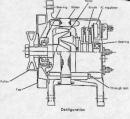12-Volt Alternators for Vintage Cars

Old car publications frequently run articles about how to convert 6-volt electrical systems to 12 volts, but little is said about the selection of the alternator.The slickest conversion might involve the use of the permanent-magnet alternator from a Kubota tractor. By eyeball measurement, it looks as if this little gem could be made to fit inside the typical generator case. And nobody would know. But the cost of the parts (around $400 for the alternator and its special regulator) and natural inertia have prevented me from trying out the idea.
That leaves us with conventional alternators, mounted in place of the original dc generator. Almost any 12-volt alternator that turns in the right direction and does not require computer control can be made to work.
Some adapt easier than others. An inexpensive alternator is better for this application than the newer and more powerful machines.
A vintage car needs no more than about 40 amps; much more than that will cook the battery, should it ever become discharged. As a point of reference, the most powerful dc generator ever offered by Chevrolet produced 55 amps and was intended for emergency vehicles with two-way vacuum-tube radios.
Among the worst choices would be the Delco CS-130 and its successor the CS-130D. Introduced in 1980 and used across the whole spectrum of GM cars, these alternators were designed to produce maximum output from the smallest and lightest package. They are also quite difficult to rebuild. The newer Ford 4G alternators follow the same design philosophy. But there are plenty of good candidates. Early Nippondensos used on Toyotas and other Japanese cars in the late 70�s and early 80�s, have about the right capacity. NDs are elegant devices, built more like industrial machinery than consumer products. If you find one in a junkyard, make certain to get the whole control circuit, which may include an external regulator, charge-lamp relay and charge lamp. Otherwise, the alternator will never work right. And get the bracket and belt-tensioning strap, because it�s easier to modify than to build from scratch. Omni-Horizon �square back� alternators are plentiful and cheap, although one cannot say much for the external solid-state regulator.
Many Delco alternators will work, including the 10D and low-output versions of the 20D.
Delco-Remy 10D
Most of my experience has been with the 10D, fitted with internal voltage regulation and excited by a wire from the ignition switch. �Rebuilt� units (cleaned and with bearings, brushes and defective parts replaced) list for around $50 at car-parts houses. You will find the serial number stamped on the alternator frame near the holddown tab:
1100893 = later production version, 12v negative ground, 55-amp output.
A two-wire female connector (Big A Auto PN 15-1304 or equivalent) plugs into the side of the unit. Some 10D connectors make up under the alternator in the 6 o�clock position, others mate at the top in the 3 o�clock position. The latter seems preferable for most installations.
Mounting Bracket
As noted earlier, it�s easier to modify a bracket than to make one. The alternator pulley must align with the engine/water-pump pulleys while holding the alternator in the same plane as the crankshaft. Elongate mounting holes and be prepared to use shims and spacer washers. Patrick�s (520 836-1117 can supply brackets to adapt GM alternators to vintage Chevrolets.